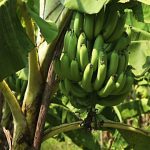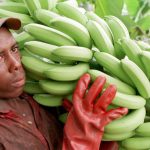
Banana plant [Getty Images]
Kenya, Uganda, Tanzania and Somalia are major producers of East African banana. Though Uganda and Tanzania lead the pack, Somalia has the highest potential: it used to be the biggest source in the post-independence days in the 1970s. Since then, the production has depreciated due to internal conflicts but still remains manageable with some 3000 hectares under the crop. In Kenya, bananas occupy a paltry portion of land but still account for 30 to 40 percent of total fruit sales according to statistics from the Ministry of Agriculture, Livestock and Fisheries.
In terms of shipping, East African countries rely virtually on sea because air means is susceptible to atmospheric changes that make bananas mashy and rot fast. For this reason the biggest margin of the shipping containers in Mombasa, Dar-es-Salaam and Mogadishu are under refrigeration.
Why refrigerate? Bananas are a highly saturated and waxy fruit. Their latex can be a problem when they start leaking: this is why the bunch is cut when still in its fantastic green, firm and unripe condition. It then receives thorough washing in cold water to stave off the external heat and partly to keep the latex from pouring off the cut stalk end.
Then it is time to prepare the fruit for the long journey through the high seas. The best temperatures for the packed fruit in the ships of early years in America according to The Atlantic were 56° Fahrenheit (13°C). Nowadays, this has been retained albeit in smart container transportation means via coolers on board the ship. This way the bananas do not come into contact with evaporated air.
How about banana shipping itself? Each of the fruits’ shipment receives controlled temperature storage in cooler containers at 13° C. This is despite the common notion that bananas need no cooling as they do well under equatorial temperatures.
Indeed, failure to keep bananas in controlled temperature fridges has several possible outcomes, all adverse. They will either make it to the delivery point in an advanced mashed potato status or they will have changed color to a brownish-yellow of rot. The lessons that shippers from the Americas learned in the late 1800s has helped capitalize on refrigeration on board vessels. Before then, exporters could lose thousands of tons each year in a matter of weeks of conveyance in normal containers. Some even sought to have whitewashed ships that could ward off sun’s rays from the vessels to maintain the green condition of the fruit.
For this reason, current shipping of bananas is highly smart monitored. As long as the fruit reaches its destination while still fresh and unripe, the importers know how to ripen it artificially in a matter of time. They keep the bunches under warm room temperatures of between 13 and 15° Celsius. This way they ripen naturally in less than a week, just enough time to have made orders with local groceries and customers.
In Africa, the shipping of bananas has transformed since the first decade of independence in the early 1970s. Then, Africa provided 14.1 percent of the global supplies. The leader as even now was Latin America with 76.8 percent of global exports. Africa’s major exporters of the fruit then were Ivory Coast followed by Somalia, Cameroon and Madagascar in that order.
In 2017, Cameroon was the biggest banana exporter from Africa. Its total sales reached $338.1 million. It was the only country to reach the top 15 from Africa. The top three exporters in the world were Ecuador, Guatemala and Costa Rica, all South American nations. The fourth in the rank was Belgium, a European nation.
In East Africa, Uganda and Tanzania are the leading sources as well as internal markets for their own fruits. Uganda sees 70 percent of its output eaten locally as matoke mash by the farmers and their families. The country exports and partially locally retails 20 percent of the fruit. The 10 percent remaining portion goes into processing such products as flour, sweet products and traditional liquor.
In Tanzania, the fifteen-month journey between transplanting and retailing the ripe banana sees the bulk of around 60 percent go into family consumption. 8 percent is reserved for sale and out of this margin the bulk goes to urban retail while a small margin is for export. Roast banana is a a popular source of revenue for banana traders in the country and represents 2 percent of Tanzania’s banana sales. The key processed uses of the local fruit include inclusion in wheat products like chapati and confectionaries like biscuits.
Statistics show that bananas from East Africa, despite burgeoning overseas’ demand remain lowly exported. This is perhaps due to concerns about ripening onboard. Other parameters per country include quality, which accounts for 33 percent of considerations for Tanzania’s would-be exporters. This is equalled by transport at 33 percent as a major reason to or not to export from Tanzania.
The main markets for Uganda and Tanzania include former colonial master, the UK and EU countries like Holland, Portugal and Holland. Boston in the US which has a sizable East African diaspora is also a target market for these two countries.
In terms of prices, the Bogoya cultivar sells highest for at least $5 per kilo while ndizi sukari (sweet variety) sells lowest for at least $6 per several kilograms’ box. The matoke cultivar or cooking banana in Uganda retails at an average $0.8 while Cavendish goes for a little less at $0.5 per kilo. Though the main beneficiaries of cost are middlemen due to the markup they get from the importers, the bulk of the low-tier beneficiaries are smallholder farmers. They grow 90 percent of the crop in Uganda.

Ugandan man carrying bananas [Getty Images]
Kenya bananas, on the other hand, occupy about 2 percent of the land under cultivation and are some of the most important sources of basic nutrition. It is one of the few export crops that do not have cooperatives to run them. Rather, brokerage is the main means of market access for most family growers. The sale of this produce to the urban centers in Nairobi generates about three times more prices than the original sources such as Western, Central and Eastern regions. For this reason, many sellers target the mainstream urban markets. About 90 percent of growers of bananas in Kenya farm less than two acres of land like their peers in the East African region.
The current yields of bananas in Kenya are about 20 tons per hectare which could double with the government’s program that began in 2013. Entitled the National Banana Strategy 2013-2016, the program seeks to use field extension drives to realize the 40 tons-per-hectare target.
In terms of value addition, Kenya has set up various processing plants, one of which is in Kisii. The value addition plant in this banana-growing town has a 270-ton production capacity each 24 hours. The factory dries the produce which enhances its shelf life. This way, farmers can convert it to concentrate (juice), fig, traditional beer, flour and jam.
Kenya bananas have high potential despite the bacterial wilt that constantly attacks the crop. Kisii to the west and Meru in the mountainous highlands to the east are the key sources of the fruit. Meru, for instance, has an output of 127, 575MT yearly, which places it at the top of the pie in 2018. The crop is under an extensive 8500 acres in this County.
 Some of the measures that Kenya has outlined to rescue its banana sector include ecological conservation. This entails buffering the weak trunks from winds occasioned by weather change through proper props. There are also suggestions to provide better nematicides to fight bacterial wilt. Other measures include the recommended picking of the fruit early in the season when the fingers are green rather than ripe. Storage is also a major control measure that the government seeks to overcome through the Warehousing Bill 2018 for the provision of professional leasing of warehouses to farmers. Current factory set up for drying bananas such as in Kisii is also doubling as a means to prolong the crop’s usable life.
Some of the measures that Kenya has outlined to rescue its banana sector include ecological conservation. This entails buffering the weak trunks from winds occasioned by weather change through proper props. There are also suggestions to provide better nematicides to fight bacterial wilt. Other measures include the recommended picking of the fruit early in the season when the fingers are green rather than ripe. Storage is also a major control measure that the government seeks to overcome through the Warehousing Bill 2018 for the provision of professional leasing of warehouses to farmers. Current factory set up for drying bananas such as in Kisii is also doubling as a means to prolong the crop’s usable life.
There is also marginal demand for value added banana from Kenya. For instance, in 2017, a new production plant began in Nairobi with an intention to ship flour made of banana to Europe.
Kenya has also made some efforts to streamline famers’ access to the banana export market. The National Banana Commission plays the role of creating export standards so as to make the fruit expand its cross-border appeal. Some of the challenges that face family growers include inaccessibility to loans: the banana body seeks to create microfinance avenues in concert with non-governmental organizations, rural banking and seed bodies. In terms of quality, the Kenya Plant Health Inspectorate Services (KePHIS) has been providing information on tissue culture and measuring the heath status of export fruits.
Somalia, on its part, was once East Africa’s largest source of bananas as well as exporter. The country in the 1970s controlled shipments from the region to the European states particularly Italy. Since the civil war that began with the ouster of Siad Barre in the early 1990s, the crop along the fertile Juba River basin has almost come to a standstill. From 12000 hectares in the ’70s, the country had just 3000 hectares remaining in the mid-’90s. At its peak, each banana field in Somalia was 40 to 300 hectares mainly under private growers. However, its strategically-placed shipping corridor is a key example of how bananas from the region go through the high seas.
Somalia’s banana exports are advantageous because the sea journey to the new markets such as Saudi Arabia, the United Arab Emirates and Iran are from five days’ to a week’s journey away. The ships have interior refrigeration systems. Currently about five such vessels depart every day from the port of Mogadishu with shipments of banana.
Despite the loss of its status as the East African export beacon, Somalia still has high potential. During the time it was coming round to recovering its banana crop after civil war-related losses in 1995, around 0.2 million hectares of farming land lay idle. Out of this land, 40,000 hectares were irrigation-ready. The bulk of this portion was under various crops, with bananas being some of the most prominent.
Some of the control measures that ensure that banana shipments remain stable in East Africa-outbound shipments include artificial temperature control. Because most ships carry multiple perishable goods under export, they designate certain sections per commodity. The section for banana for example receives temperature regulation up to a tenth of each degree variation. They also use nitrogen as the gas that can generate an atmosphere that replicates that of growth to prevent ripening.
It is also the privilege of shipping that ammonia gas is used to keep the fridge temperatures under control and create a vacuum environment. Besides, there are ozone gas generation equipment that counteract the formation of environmental changes that allow the breeding of microbes such as fungi. Other than the vacuum environment, the bananas also receive unvarying airflow to maintain the fruits’ optimum environmental preservation.
In short, the various agendas per country in East Africa all seek to revitalize the banana collective sector’s potential. While in Kenya efforts to double yields are ongoing, in Uganda the focus is for more disease-resistant varieties while Tanzania is keen to boost its low exports. Somalia is still revamping the Shabelle region’s former glory as the banana heartland of East Africa. This is important as the banana is a chief food source for the region. Indeed, some 400 million people across third world countries depend on the crop for primary subsistence.
References
https://www.theatlantic.com/health/archive/2011/12/the-life-cycle-of-a-banana/249551/
http://www.ediblegeography.com/spaces-of-banana-control/
http://aei.pitt.edu/33868/1/A574_1.pdf
https://www.standardmedia.co.ke/business/article/2001266555/bored-with-miraa-smart-farmers-in-meru-go-bananas
https://www.kilimotrust.org/Banana%20Final%20Report%20-%20Interactive.pdf
http://www.new-ag.info/pdf/SAMSAM-report.pdf
http://www.sh-congress.com/resources/documents/1321349597philipgray.pdf
http://hortfreshjournal.com/old/articles/30_energizingbanana.pdf
http://www.worldstopexports.com/bananas-exports-country/
http://www.faoswalim.org/resources/Agriculture/Banana_sector_study_for_Somalia/Preliminary_assesment_strategic_options_report.pdf
https://www.theguardian.com/global-development/2017/dec/12/gm-genetically-modified-banana-uganda-hunger-crisis

